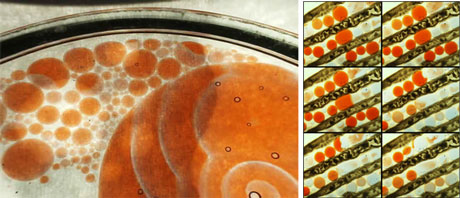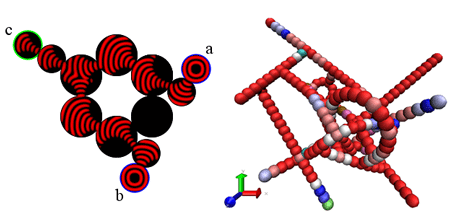Following the analogy of biological neurons, the NEUNEU (Artificial Wet Neuronal Networks from Compartmentalized Excitable Chemical Media) project aims at using droplets of a chemical reaction medium to process information. In this EU project, the excitable chemical Belousov-Zhabotinsky medium is packaged into small lipid-coated droplets which form the elementary components of a liquid information processing medium. Droplets communicate through chemical signals and excitation propagates from droplet to droplet. Among the future applications of molecular information processors is their potential for fine grained control of chemical reaction processes.
Our modern society and technology is very much dependent on smart automatic control devices, from cell-phones and electronic driver assistance systems in cars to computer controlled manufacturing processes. In the area of chemical production processes, however, the level of control achieved so far is crude compared with what is seen in nature. Living cells craft molecules one-by-one with quality control directly at the assembly stage of each molecule. In contrast, chemical technology controls reaction conditions only at the level of bulk materials and subsequently the desired product needs to be extracted from the mixture of substances formed in the reaction process. As a consequence, the complexity of molecules and the concomitant functionality of materials that can be manufactured today falls far short of those seen in nature.
Attempts to achieve an increasingly finer control of chemical production processes currently face the challenge of bridging from electronic control technology to the surfaces that mediate chemical reactions. In a different approach, the NEUNEU project aims to include computational capabilities directly into different media, migrating the control from a conventional computer outside the system of interest directly into the system itself, eliminating the need for a complicated interface.
Another interesting application of molecular information technology is the potential for smart drugs, capable of performing elementary logical decisions to determine whether the right position in space and time is reached to release certain drugs. This would not only make the use of drugs more convenient for the patient but also lead to more effective and reliable medications.
Before information technology can be tightly interwoven with chemical and biochemical systems, however, it will be necessary to find out where the concepts of conventional information processing can be mapped into the chemical realm and where new paradigms need to be developed. The NEUNEU project decided to explore this path with a minimal system that exhibits the properties (signal transmission, signal gain, self-repair) desirable for a molecular information processing architecture that harbors the potential to scale to applications.

Figure 1: From left: A) Belousov–Zhabotinsky activation waves propagating in 1 to 10 millimeter sized lipid-coated droplets in oil (Credit: Gorecki Lab, Warsaw). (B) Manually aligned droplets of BZ-reaction medium (Credit: Josephine Corsi, Univ. of Southampton).
To explore the concept of performing computations with excitable media we use the Belousov-Zhabotinsky (BZ) medium. The BZ reaction was discovered in the 1950s to be an oscillating reaction, existing far from the thermodynamic equilibrium. Though there are variations, the BZ-mixture can be prepared from potassium bromide, malonic acid, sodium bromate, sulfuric acid and ferroin as redox indicator.
When the system is oscillating, the indicator is continuously switching between its oxidized and reduced form, changing its color between blue and red or between red and white, as seen in Figure 1. Stirring the system leads the whole mixture to exhibit similar behaviour in all parts of the test tube. On the contrary, leaving the mixture relatively undisturbed in a flat petri dish, the BZ medium generates beautiful two-dimensional wave patterns.
Because we want to control the signals that are transmitted through the chemical medium, continuous excitations are not desirable in this project. Here, the BZ medium is mixed in proportions that do not allow a spontaneous start of an oscillation. Instead, the excitation needs to be triggered from the outside (eg, by a silver wire) or by an already existing excitation wave. Hence we call the state of the medium "excitable" or "sub-excitatory". When the medium is excitable, a wave propagates equally in every direction. So the state of a droplet can be simplified by assuming a well-stirred reactor for each droplet.

Figure 2a, 2b (left): Examples of microfluidic structures for generation and handling of droplets. Figure 2c (right): Generation of a droplet within a microfluidic structure (not visible).
Using the "sub-excitatory" condition alternatively, we can also include logic elements inside single large drops. In this case, waves do not spread in every direction, but preserve their shape and direction as illustrated in Figure 3A.
When we drop water containing BZ medium into oil, the phases do not merge and droplets form automatically. We are going to use microfluidics to produce droplets of smaller volumes, with higher precision, and in large quantities (Figure 2). Wrapping up the BZ reaction into these small droplets has the advantage of discretizing the otherwise continuously propagating excitations into precise units.
Lipid molecules contained in the oil phase self-assemble at the surface of the droplets and stabilize the droplets against merging. Living cells are also covered with lipids, but in this case lipids assemble between two aqueous compartments and therefore form the double layer typical for biomembranes. The amphiphilic lipid molecules assembling at the border between the oil and and the "water with BZ" phase, produce a lipid monolayer in our system.

Figure 3a (left) Simulation of directed waves in sub-excitable medium within a network of droplets with two different inputs a, b and output c (image by Julian Holley, University of the West of England, for animation see link below). 3b: Stochastic 3-D simulation of a droplet network counting the number of activated inputs (image by Gerd Gruenert, FSU Jena).
When two of the droplets come into contact, the lipid monolayers coating each droplet can form a double layer similar to a biological membrane. As a consequence it is possible to insert membrane channel proteins at the interface between two droplets to facilitate the exchange of chemical compounds and consequently the propagation of the BZ medium excitation from droplet to droplet.
By varying the coupling between droplets, the droplet radii, and BZ medium compositions, we will generate droplets with a wide variety of properties, such as excitability, oscillation phase length or refractory times. Controlling these properties should allow us to engineer droplet networks with computational capabilities as for example shown in Figure 3B.
The NEUNEU project is funded by the EU Seventh Framework Programme for three years (FP7, ICT, FET, see link below) since February 2010. It brings together biochemical experimentalists as well as theoretical computer scientists. In the team of Maurits de Planque and Klaus-Peter Zauner (University of Southampton) and Jerzy Gorecki’s lab (Institute of Physical Chemistry, Polish Academy of Sciences, Warsaw) the physics and chemistry of small lipid droplets and of the Belousov-Zhabotinsky reaction are investigated, both theoretically and practically. The theoretical foundations, implications and possibilities of droplet based computing devices are elaborated in the research groups of Andy Adamatzky (University of the West of England, Bristol) and Peter Dittrich (Bio Systems Analysis Group, Friedrich-Schiller-University Jena).
For further recent activities in European BioChem IT research see the COBRA initiative (link below).
Links:
http://www.neu-n.eu/
http://uncomp.uwe.ac.uk/holley/sim/ sim.html
http://www.cobra-project.eu
http://cordis.europa.eu/fp7/ict/ programme/fet_en.html
Please contact:
Peter Dittrich
Friedrich Schiller University Jena
Tel.: +49 3641 946460 begin_of_the_skype_highlighting +49 3641 946460 end_of_the_skype_highlighting
E-mail:










